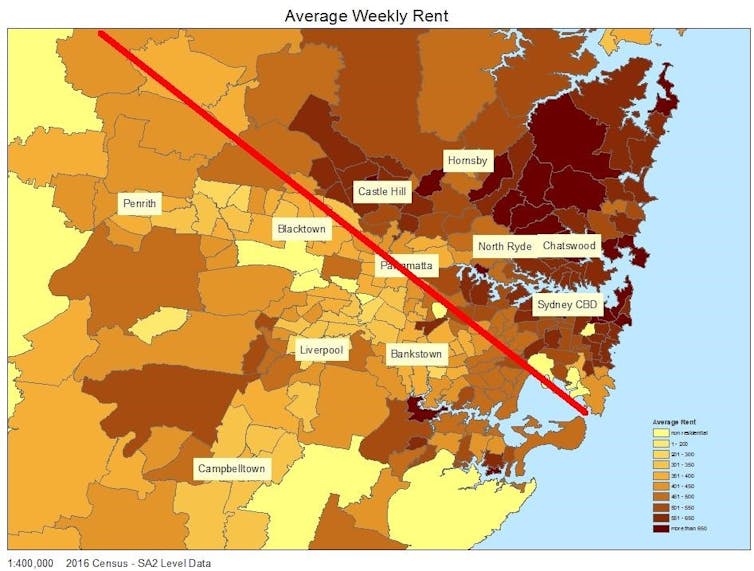access to jobs divides Sydney along the 'latte line'
- Written by Chyi Lin Lee, Associate Professor of Property, Western Sydney University
Sydney’s so-called “latte line” divides the city in two by jobs. Specifically, our research shows residents are segregated by both overall access to jobs and access to white-collar jobs. This highlights the jobs inequality underlying residential segregation.
The white-collar jobs, in general, are concentrated in the north and east of the city (above the latte line). The blue-collar jobs are mainly located in the south and west (below the line).
Public transport connections from south to north are poor. Housing costs are much higher in the northern part. This causes a commuting issue for residents who live south of the latte line, where housing is more affordable, if they are to do the white-collar jobs that are concentrated in the north.
Managers and professionals who live in the south and west of Sydney are likely to have longer commute times to work.
Given the severe spatial mismatch between jobs and where people live, policymakers need to take urgent action to close the employment gap between the two segments of Sydney. This is a key element in building a more productive, sustainable and liveable Greater Sydney.
Read more: Our big cities are engines of inequality, so how do we fix that?
So where exactly is the ‘latte line’?
The latte line roughly starts from Sydney International Airport and extends towards Parramatta, and then up to the northwest region. The line generally indicates a socioeconomic division between the northeastern and southwestern regions of metropolitan Sydney.
Metropolitan Sydney is large. However, geographically, jobs are not evenly distributed. More jobs are concentrated in the north and east regions, causing the problem of long-distance commute for those living in the west and south.
Based on Australian Bureau of Statistics (ABS) 2016 Census data, Figure 1 shows jobs are not evenly distributed – there are more jobs in the east and the north.
 Figure 1: Location of jobs in metropolitan Sydney (darker areas indicate more jobs)
Author provided
Figure 1: Location of jobs in metropolitan Sydney (darker areas indicate more jobs)
Author provided
Furthermore, white-collar and blue-collar jobs are unevenly distributed across Sydney. Figure 2 shows that typical white-collar jobs, such as managerial and professional jobs, are mainly concentrated in the northern and eastern parts of Sydney. The outliers are related to military lands, medical precincts or higher education precincts.
 Figure 2: Ratio of managerial and professional jobs to total jobs (darker areas indicate more white-collar jobs)
Author provided
Figure 2: Ratio of managerial and professional jobs to total jobs (darker areas indicate more white-collar jobs)
Author provided
Thus, those managers and professionals who live in the south and west parts of Sydney are more likely to have longer commute times to their workplaces, particularly for managerial jobs in the North Shore and Macquarie Business Park areas.
The typical blue-collar jobs, including labourers, machine operators and trades, are generally located in the south and the west. Figure 3 clearly highlights the gap between white-collar and blue-collar jobs distribution in Sydney.
 Ratio of labourers, machine operators and drivers, technicians and trades jobs to total jobs (darker areas indicate more blue-collar jobs)
Author provided
Ratio of labourers, machine operators and drivers, technicians and trades jobs to total jobs (darker areas indicate more blue-collar jobs)
Author provided
Can the gap be closed?
To close the gap, three possible solutions can be considered:
- provide more affordable housing in the north
- move or create more professional jobs in the south
- provide better public transport links from west and southwest to the north.
The “not in my backyard” (NIMBY) attitude of residents of the eastern and northern areas to a certain extent limits the supply of new dwellings, which might otherwise improve housing affordability. Housing costs on the north side of the line are much higher than in the south. Figure 4 shows this clearly.
 Figure 4: Average weekly rents in metropolitan Sydney (darker areas indicate higher housing costs)
Author provided
Figure 4: Average weekly rents in metropolitan Sydney (darker areas indicate higher housing costs)
Author provided
The local government areas located below the line generally are more willing to accommodate new development. The increase in housing supply tempers housing costs in this region. The result is a widening gap in housing costs between the north and the south.
This situation leaves policymakers with three options.
The first is to encourage affordable housing development in the north.
The second option is to create more white-collar jobs in the west and south, particularly in the second CBD, Parramatta. This is much better connected with the southern and western suburbs via rail and bus links. However, Parramatta has a poor train connection with the major jobs hub of the Macquarie Park area.
This brings us to the third option: provide better public transport connectivity between the two segments of Sydney.
Read more: Your local train station can predict health and death
Residents of western and southwestern parts of metropolitan Sydney would have better access to white-collar jobs if Parramatta were connected to the Macquarie Park district. The forgotten Parramatta-to-Epping rail link would provide that access. It would also significantly enhance the connectivity between Parramatta and Hornsby.
Authors: Chyi Lin Lee, Associate Professor of Property, Western Sydney University





